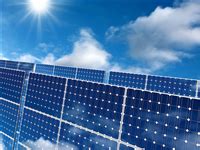新能源玻璃有几种类型的
Types of New Energy Glass
New energy glass, also known as smart glass or dynamic glass, is a type of glass that can change its properties based on external stimuli such as light, heat, or voltage. These glasses are gaining popularity due to their energy efficiency and ability to enhance comfort and privacy in various environments. Let's explore the different types of new energy glass:
Electrochromic glass, or EC glass, is a type of glass that can change its tint or opacity in response to an applied voltage. It consists of multiple layers, including a transparent conductor, an electrochromic layer, and an ion conductor. When a small electric current is applied, ions migrate between these layers, causing a change in color or transparency.
Applications: Electrochromic glass is commonly used in windows, skylights, and partitions in buildings to control sunlight and glare, thus reducing the need for heating, cooling, and artificial lighting.
Thermochromic glass is sensitive to temperature changes and can alter its transparency or color accordingly. This type of glass contains microcapsules or nanoparticles that change their optical properties when exposed to heat.
Applications: Thermochromic glass is often utilized in automotive sunroofs, greenhouses, and energyefficient windows to regulate solar heat gain and enhance thermal comfort.
Photochromic glass darkens when exposed to ultraviolet (UV) radiation, such as sunlight, and returns to its clear state when the UV light diminishes. This reversible process is due to the presence of photoactive molecules, typically silver halides or organic compounds, embedded within the glass.
Applications: Photochromic glass is commonly used in eyeglasses, sunglasses, and automobile windshields to provide protection against glare and harmful UV rays.
Liquid crystal glass consists of a layer of liquid crystals sandwiched between two transparent electrodes. By applying an electric field, the orientation of the liquid crystal molecules can be controlled, altering the light transmission properties of the glass.
Applications: LC glass is utilized in privacy partitions, projection screens, and electronic display devices where switchable transparency is desired.
SPD glass contains microscopic particles suspended in a liquid or polymer matrix. When an electric current is applied, these particles align to control the passage of light through the glass, effectively changing its tint or opacity.
Applications: SPD glass is used in windows, sunroofs, and skylights to modulate daylighting and provide occupants with customizable levels of privacy and glare control.

Each type of new energy glass offers unique features and benefits, catering to diverse architectural, automotive, and technological applications. By understanding the characteristics of these glasses, designers, engineers, and consumers can make informed decisions to optimize energy efficiency, comfort, and aesthetics in various environments.
